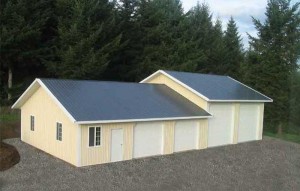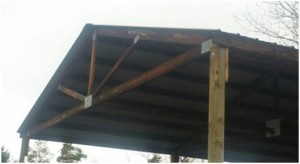Today‘s guest blog is written by a fellow Rotarian of mine, Rich Wilson, who is an Insurance and
Financial Services Agent for Farmers Insurance out of Coeur d ‘Alene, ID.
So you want to build a pole building structure behind your home. So how does pole building insurance work?
 It’s always best to check with your local contractor’s board and insurance company to make sure you are following all local, state and federal requirements before you start the project.
It’s always best to check with your local contractor’s board and insurance company to make sure you are following all local, state and federal requirements before you start the project.
Here are some basic areas to be aware of with a couple different scenarios.
Let’s say you have decided you want to be the general contractor for this project. The first thing to be concerned about is your liability. What if someone you hire gets hurt? What if an excavator damages your home? In each of these circumstances, you as the general contractor could be liable and typically your homeowner’s insurance will not cover it. What you’ll need is a commercial policy for general liability insurance. Additionally, if you hire employees you will need a worker’s compensation policy. Many times you will hire sub-contractors to do some or all of the work. This is where it becomes very important you do your homework. If they are subs, not employees, they will likely need to have their own insurance. What’s critical is that it is up to you as the general contractor to verify their coverage because unless your business policy clearly states subs are covered, your claim may be denied. So get a copy of each of your subs certificate of liability and have them name you as an additional insured. If you are having friends help, your homeowner’s policy may cover your liability should they get hurt on your premise but it won’t cover paid sub-contractors, so be careful.
Now what about your materials while the building is being built? Being the homeowner, your homeowner’s insurance policy will typically cover the cost of materials being used to build your new structure under personal property (check with your individual company because each policy and state may vary.) So, if you have a substantial amount of building materials on site, you should consider increasing your personal property coverage. There are some exclusions to be aware of; things like weather damage and mold are typical exclusions should you not properly secure your building or materials.
What about once the building is built? Are we done yet? There is one more important step to consider insurance wise once your structure is complete. The typical homeowner’s policy defaults to 10% of your primary dwelling coverage for separate structures. Say your dwelling coverage is $250K, your separate structures are probably only covered for $25K. So since you know what it costs to build, you will want to increase your separate structures coverage accordingly. One thing to keep in mind is in the event of a loss, separate structures will include all non-attached buildings (read detached garage or shop) and fencing. So if you have a detached garage, new barn and an acre of fence you will want to insure for the combined value.
One more note of caution. Today there are many contractors and subs who have been downsized and are looking for work. That may present what seems like an opportunity. Just remember it’s your responsibility to double check to make sure their insurance and licenses are in order. Being cautious here could save you thousands when someone is hurt on the job site or digs into your sewer lines.
Thanks Rich, this is great stuff!
To contact Rich – email him at: rwilson1@farmersagent.com
Mike








